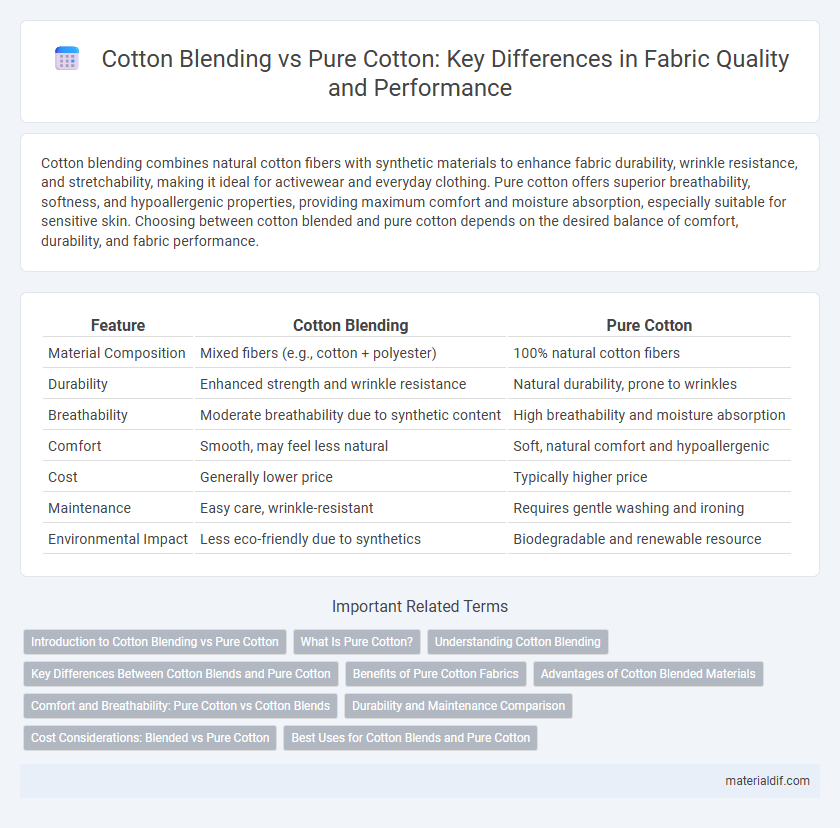Cotton blending combines natural cotton fibers with synthetic materials to enhance fabric durability, wrinkle resistance, and stretchability, making it ideal for activewear and everyday clothing. Pure cotton offers superior breathability, softness, and hypoallergenic properties, providing maximum comfort and moisture absorption, especially suitable for sensitive skin. Choosing between cotton blended and pure cotton depends on the desired balance of comfort, durability, and fabric performance.
Table of Comparison
| Feature | Cotton Blending | Pure Cotton |
|---|---|---|
| Material Composition | Mixed fibers (e.g., cotton + polyester) | 100% natural cotton fibers |
| Durability | Enhanced strength and wrinkle resistance | Natural durability, prone to wrinkles |
| Breathability | Moderate breathability due to synthetic content | High breathability and moisture absorption |
| Comfort | Smooth, may feel less natural | Soft, natural comfort and hypoallergenic |
| Cost | Generally lower price | Typically higher price |
| Maintenance | Easy care, wrinkle-resistant | Requires gentle washing and ironing |
| Environmental Impact | Less eco-friendly due to synthetics | Biodegradable and renewable resource |
Introduction to Cotton Blending vs Pure Cotton
Cotton blending combines natural cotton fibers with synthetic materials such as polyester or rayon to enhance fabric durability, wrinkle resistance, and cost-effectiveness, making it ideal for everyday wear and industrial use. Pure cotton fabric offers superior breathability, softness, and hypoallergenic properties, preferred for comfort-focused applications like bedding and casual clothing. Understanding the balance between cotton blending and pure cotton helps consumers make informed choices based on performance, maintenance, and comfort needs.
What Is Pure Cotton?
Pure cotton refers to fabric made entirely from natural cotton fibers without any synthetic blends, offering maximum breathability, softness, and hypoallergenic properties. Its 100% natural composition ensures excellent moisture absorption and durability, making it ideal for sensitive skin and high-quality clothing. Compared to cotton blends, pure cotton garments maintain better breathability and comfort but may wrinkle more easily and have less elasticity.
Understanding Cotton Blending
Cotton blending involves mixing cotton fibers with other materials like polyester or rayon to enhance fabric durability, wrinkle resistance, and moisture management. Pure cotton offers natural breathability and softness but tends to wrinkle and shrink more than blends. Understanding cotton blending helps consumers choose fabrics that balance comfort, maintenance, and performance according to their needs.
Key Differences Between Cotton Blends and Pure Cotton
Cotton blends combine natural cotton fibers with synthetic materials like polyester to enhance durability, wrinkle resistance, and moisture-wicking properties, whereas pure cotton consists solely of natural cotton fibers, offering superior breathability and softness. Pure cotton garments are more prone to shrinkage and wrinkles, but they provide a natural hypoallergenic quality beneficial for sensitive skin. The choice between cotton blends and pure cotton largely depends on the desired balance of comfort, performance, and maintenance in textile applications.
Benefits of Pure Cotton Fabrics
Pure cotton fabrics offer superior breathability and moisture absorption compared to cotton blends, making them ideal for sensitive skin and warm climates. They maintain natural softness and durability without the inclusion of synthetic fibers, enhancing comfort and longevity. Pure cotton's hypoallergenic properties reduce irritation risks, promoting healthier wear for individuals with allergies or skin sensitivities.
Advantages of Cotton Blended Materials
Cotton blended materials offer enhanced durability and wrinkle resistance compared to pure cotton, making them ideal for everyday wear and easy care. Blending cotton with synthetic fibers like polyester improves moisture-wicking properties and color retention, extending the garment's lifespan. These fabrics also provide better stretch and shape retention, ensuring comfort and a consistent fit over time.
Comfort and Breathability: Pure Cotton vs Cotton Blends
Pure cotton offers superior breathability and natural moisture-wicking properties, ensuring maximum comfort by allowing air to circulate freely and keeping the skin dry. Cotton blends, often combined with synthetic fibers like polyester, enhance durability and wrinkle resistance but may reduce softness and airflow compared to pure cotton. Choosing between pure cotton and cotton blends involves balancing comfort and breathability against fabric strength and maintenance needs.
Durability and Maintenance Comparison
Cotton blending typically enhances durability by combining fibers like polyester, which resist wear and tear better than pure cotton. Pure cotton offers superior breathability and softness but may shrink or wrinkle more easily, requiring careful maintenance. Blended cotton fabrics usually require less frequent ironing and maintain their shape longer, making them more practical for everyday use.
Cost Considerations: Blended vs Pure Cotton
Cotton blending reduces production costs by combining natural cotton fibers with synthetic materials like polyester, which are cheaper and enhance durability. Pure cotton garments generally have higher manufacturing expenses due to the need for 100% natural fibers, leading to increased raw material and processing costs. Consumers often face lower prices with blended cotton products, while pure cotton typically commands a premium for its breathability and softness.
Best Uses for Cotton Blends and Pure Cotton
Cotton blends combine natural cotton fibers with synthetic materials like polyester, offering enhanced durability, wrinkle resistance, and moisture-wicking properties, making them ideal for activewear, everyday clothing, and affordable home textiles. Pure cotton provides superior breathability, softness, and hypoallergenic qualities, making it the preferred choice for sensitive skin, premium bedding, and high-quality casual wear. Choosing between cotton blends and pure cotton depends on the desired balance between comfort, durability, and ease of care suited to specific applications.
Cotton Blending vs Pure Cotton Infographic

 materialdif.com
materialdif.com